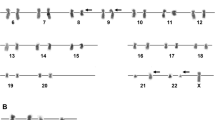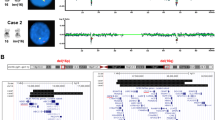Abstract
Fluorescence in situ hybridization analysis (FISH) using a CBFB breakapart probe is widely used to detect CBFB rearrangement (CBFBr) in cases of acute myeloid leukemia (AML). However, detection of 3′CBFB deletion (3′CBFBdel) often poses a challenge for interpretation, and the clinical importance of 3′CBFBdel associated CBFBr remains largely unknown. We identified 16 AML patients with 3′CBFBdel, 11 (69%) of which were confirmed to have CBFB::MYH11 fusion. These 11 patients presented with de novo AML; 10 showed myelomonocytic differentiation, 8 had a prominent eosinophilic component, and 7 showed characteristic eosinophils with basophilic granules. Next generation sequencing showed mutations in 7/8 patients, 5 with KRAS/NRAS, 3 with FLT3-TKD, but none with KIT mutations. Except for one patient who died 5 days after diagnosis of AML, all 10 patients received chemotherapy and achieved remission initially. However, within 3 years, 5 (50%) patients had relapsed, of whom, 1 died and 4 received hematopoietic stem cell transplant. After a median follow-up of 76 months, 3 patients died and 8 were alive in complete remission. Our study shows that detection of 3′CBFBdel is not equivalent to unbalanced CBFB rearrangement, and therefore, an alternative confirmatory test is warranted. AML with 3′CBFBdel/CBFBr often shows similar pathological features to AML with inv(16), but appears to have different mutation profiles and a higher risk of relapse requiring hematopoietic stem cell transplant.



Similar content being viewed by others
References
Le Beau MM et al (1983) Association of an inversion of chromosome 16 with abnormal marrow eosinophils in acute myelomonocytic leukemia. a unique cytogenetic-clinicopathological association. N Engl J Med 309(11):630–636
Marlton P et al (1995) Molecular characterization of 16p deletions associated with inversion 16 defines the critical fusion for leukemogenesis. Blood 85(3):772–779
Liu P et al (1993) Fusion between transcription factor CBF beta/PEBP2 beta and a myosin heavy chain in acute myeloid leukemia. Science 261(5124):1041–1044
Batanian JR, Huang Y, Fallon R (2000) Deletion of 3′-CBFB gene in association with an inversion (16)(p13q22) and a loss of the Y chromosome in a 2-year-old child with acute myelogenous leukemia-M4. Cancer Genet Cytogenet 121(2):216–219
Dohner H et al (2017) Diagnosis and management of AML in adults: 2017 ELN recommendations from an international expert panel. Blood 129(4):424–447
Borthakur G et al (2014) Gemtuzumab ozogamicin with fludarabine, cytarabine, and granulocyte colony stimulating factor (FLAG-GO) as front-line regimen in patients with core binding factor acute myelogenous leukemia. Am J Hematol 89(10):964–968
Burnett AK et al (2013) Optimization of chemotherapy for younger patients with acute myeloid leukemia: results of the medical research council AML15 trial. J Clin Oncol 31(27):3360–3368
Borthakur G, Kantarjian H (2021) Core binding factor acute myelogenous leukemia-2021 treatment algorithm. Blood Cancer J 11(6):114
Borthakur G et al (2008) Treatment of core-binding-factor in acute myelogenous leukemia with fludarabine, cytarabine, and granulocyte colony-stimulating factor results in improved event-free survival. Cancer 113(11):3181–3185
Hospital MA et al (2014) Core-binding factor acute myeloid leukemia in first relapse: a retrospective study from the French AML Intergroup. Blood 124(8):1312–1319
Kadkol SS et al (2004) Comprehensive analysis of CBFbeta-MYH11 fusion transcripts in acute myeloid leukemia by RT-PCR analysis. J Mol Diagn 6(1):22–27
van Dongen JJ et al (1999) Standardized RT-PCR analysis of fusion gene transcripts from chromosome aberrations in acute leukemia for detection of minimal residual disease. Report of the BIOMED-1 Concerted action: investigation of minimal residual disease in acute leukemia. Leukemia 13(12):1901–28
Kelly J et al (2005) 3′CBFbeta deletion associated with inv(16) in acute myeloid leukemia. Cancer Genet Cytogenet 162(2):122–126
Dawson AJ et al (2011) Inversion and deletion of 16q22 defined by array CGH, FISH, and RT-PCR in a patient with AML. Cancer Genet 204(6):344–347
Egan N et al (2004) Deletion of CBFB in a patient with acute myelomonocytic leukemia (AML M4Eo) and inversion 16. Cancer Genet Cytogenet 154(1):60–62
Hung D et al (2007) Deletion of 3′CBFbeta in an inv(16)(p13.lq22) ascertained by fluorescence in situ hybridization and reverse-transcriptase polymerase chain reaction. Cancer Genet Cytogenet 172(1):92–4
Kolomietz E et al (2001) Primary chromosomal rearrangements of leukemia are frequently accompanied by extensive submicroscopic deletions and may lead to altered prognosis. Blood 97(11):3581–3588
Lv L, Yu J, Qi Z (2020) Acute myeloid leukemia with inv(16)(p13.1q22) and deletion of the 5′MYH11/3′CBFB gene fusion: a report of two cases and literature review. Mol Cytogenet 13:4
Spencer DV et al (2007) Inverted and deleted chromosome 16 with deletion of 3’CBFB identified by fluorescence in situ hybridization. Cancer Genet Cytogenet 179(1):82–84
Tirado CA et al (2010) Acute myeloid leukemia with inv(16) with CBFB-MYH11, 3′CBFB deletion, variant t(9;22) with BCR-ABL1, and del(7)(q22q32) in a pediatric patient: case report and literature review. Cancer Genet Cytogenet 200(1):54–59
Tang G et al (2021) Myeloid/lymphoid neoplasms with FLT3 rearrangement. Mod Pathol 34(9):1673–1685
Yang RK, et al (2021) CBFB break-apart FISH testing: an analysis of 1629 AML cases with a focus on atypical findings and their implications in clinical diagnosis and management. Cancers (Basel). 13(21)
Schlenk RF et al (2004) Individual patient data-based meta-analysis of patients aged 16 to 60 years with core binding factor acute myeloid leukemia: a survey of the German Acute Myeloid Leukemia Intergroup. J Clin Oncol 22(18):3741–3750
Appelbaum FR et al (2006) The clinical spectrum of adult acute myeloid leukaemia associated with core binding factor translocations. Br J Haematol 135(2):165–173
Delaunay J et al (2003) Prognosis of inv(16)/t(16;16) acute myeloid leukemia (AML): a survey of 110 cases from the French AML Intergroup. Blood 102(2):462–469
Paschka P et al (2006) Adverse prognostic significance of KIT mutations in adult acute myeloid leukemia with inv(16) and t(8;21): a cancer and leukemia group B study. J Clin Oncol 24(24):3904–3911
Paschka P et al (2013) Secondary genetic lesions in acute myeloid leukemia with inv(16) or t(16;16): a study of the German-Austrian AML Study Group (AMLSG). Blood 121(1):170–177
Author information
Authors and Affiliations
Corresponding author
Ethics declarations
Ethical approval
All procedures performed in studies involving human participants were in accordance with the ethical standards of the institutional and/or national research committee and with the 1964 Helsinki Declaration and its later amendments or comparable ethical standards. This article does not contain any studies with animals performed by any of the authors.
Consent to participate
Informed consent was obtained from all individual participants included in the study.
Conflict of interest
The authors declare no competing interests.
Additional information
Publisher's note
Springer Nature remains neutral with regard to jurisdictional claims in published maps and institutional affiliations.
Supplementary Information
Below is the link to the electronic supplementary material.
Rights and permissions
About this article
Cite this article
Tang, G., Zou, Y., Wang, S.A. et al. 3′CBFB deletion in CBFB-rearranged acute myeloid leukemia retains morphological features associated with inv(16), but patients have higher risk of relapse and may require stem cell transplant. Ann Hematol 101, 847–854 (2022). https://doi.org/10.1007/s00277-022-04767-1
Received:
Accepted:
Published:
Issue Date:
DOI: https://doi.org/10.1007/s00277-022-04767-1




